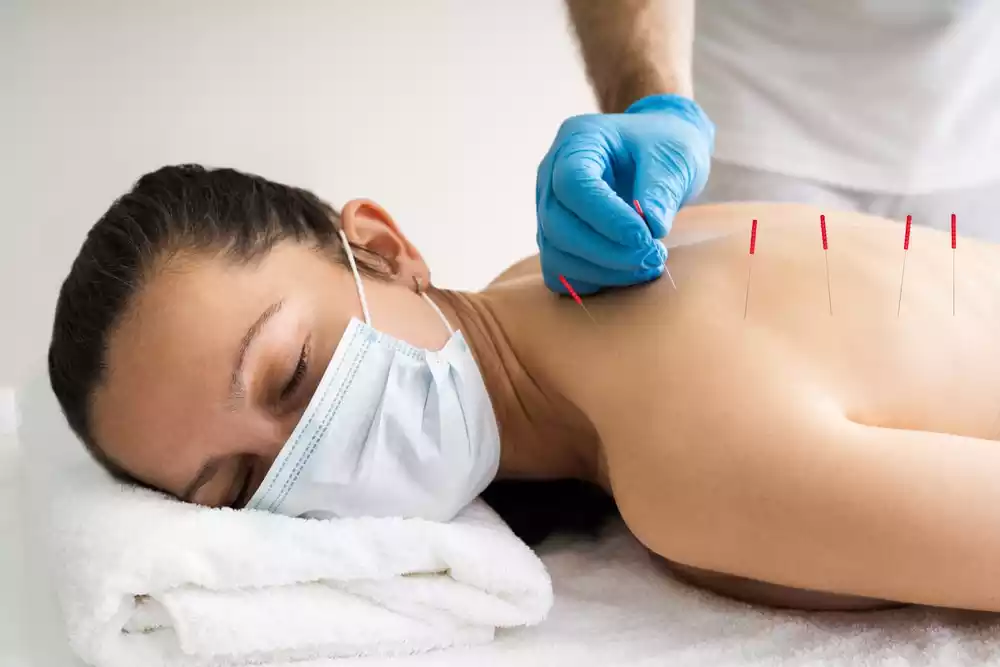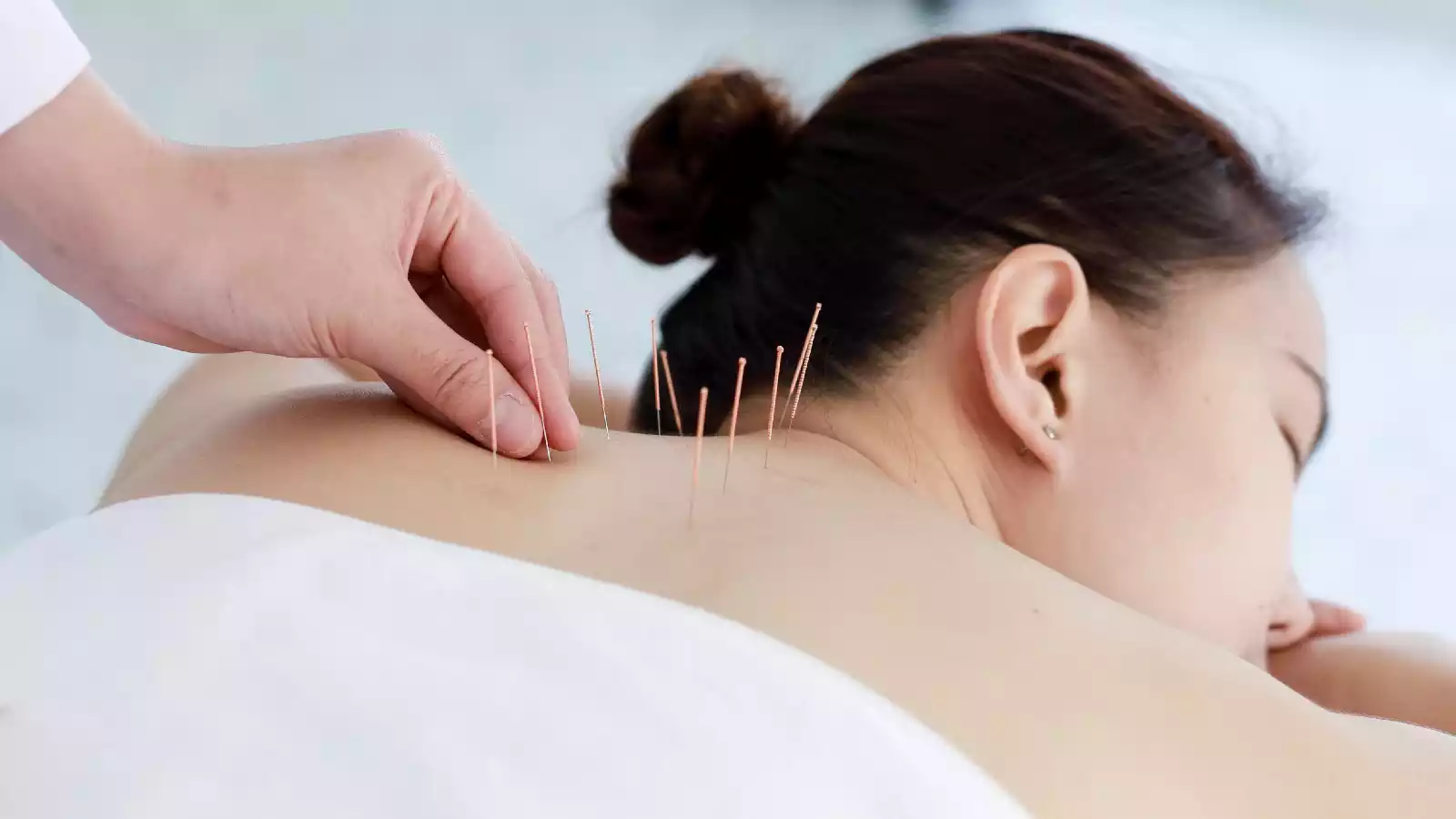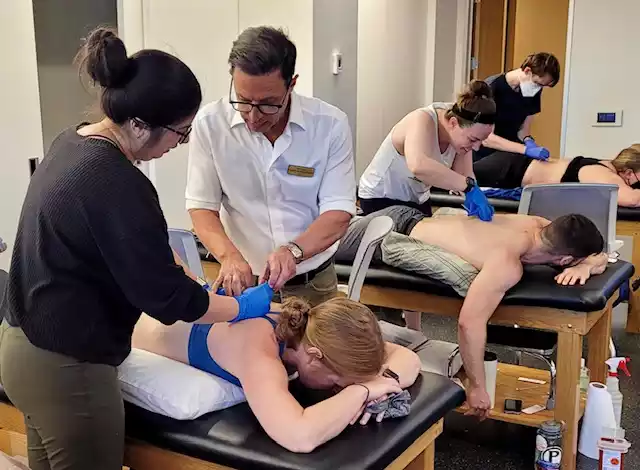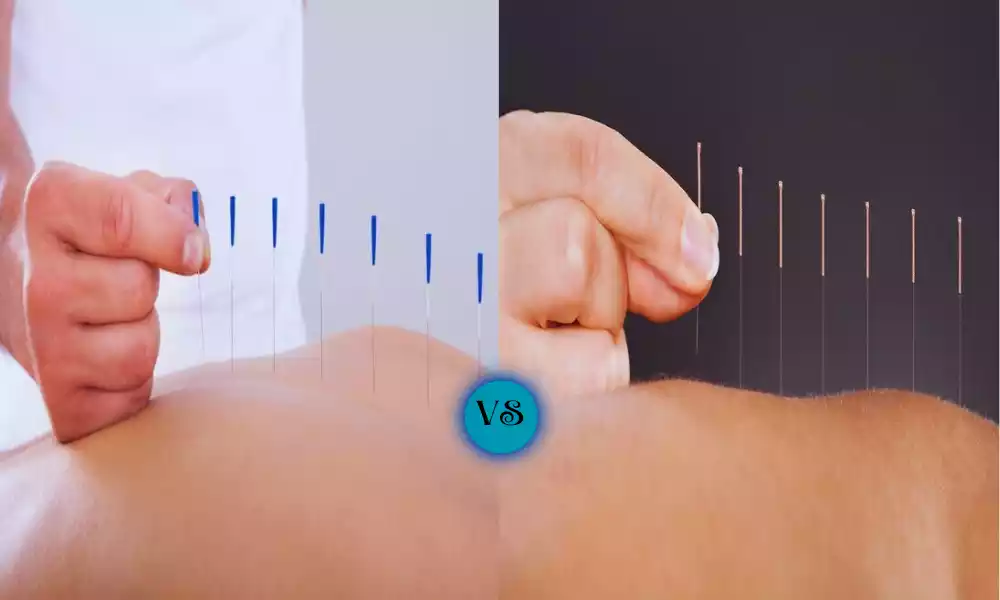Dry Needling and Acupuncture are two distinct therapeutic techniques that involve the insertion of fine needles into the body for various health-related purposes. While they share the use of needles, they have different origins, philosophies, and applications. Dry Needling, rooted in Western medicine, primarily targets myofascial trigger points to relieve musculoskeletal pain and dysfunction.
Acupuncture, originating from Traditional Chinese Medicine (TCM), aims to balance the flow of Qi (energy) through meridian points to address a wide range of physical and emotional ailments. Understanding the differences between these approaches is essential for individuals seeking effective and tailored treatments for their specific health needs.
Origins and history
Here’s a brief overview of the origins and history of both Dry Needling and Acupuncture:
Dry Needling
Origins:
- Dry Needling is rooted in Western medicine and has its origins in the latter part of the 20th century.
- It draws inspiration from various medical and therapeutic practices that involve the insertion of needles into the body to alleviate pain and promote healing.
History:
- The modern concept of Dry Needling is often attributed to Dr. Janet Travell, an American physician who specialized in pain management.
- Dr. Travell developed the idea of myofascial trigger points, which are tight knots of muscle fibers associated with pain and dysfunction.
- She explored the use of injections and needling techniques to relieve muscular pain.
- Dry Needling gained prominence in the field of physical therapy and musculoskeletal rehabilitation as physical therapists began incorporating it into their practice.
Acupuncture
Origins:
- Acupuncture is one of the oldest healing practices in the world, with its origins dating back over 2,500 years.
- It originated in ancient China as part of Traditional Chinese Medicine (TCM).
- The practice is deeply rooted in Chinese philosophy and cosmology, with its principles of balancing energy (Qi) and harmonizing Yin and Yang.
History:
- The earliest known text on Acupuncture is the “Huangdi Neijing” or “Yellow Emperor’s Inner Canon,” which was written around 100 BCE. This text laid the foundation for Acupuncture theory, introducing concepts such as meridians and the flow of Qi.
- Acupuncture gradually spread to neighboring Asian countries like Japan and Korea, where it was adapted and integrated into their own healing traditions.
- In the 20th century, Acupuncture underwent a resurgence in China, particularly during the Cultural Revolution, when it was promoted as a part of the integration of traditional and Western medicine.
- Acupuncture was introduced to the United States in the 1970s, and since then, it has become increasingly popular as a complementary and alternative therapy, gaining recognition in Western medical circles.
- Scientific research has explored its mechanisms of action and effectiveness in treating various conditions, leading to a more evidence-based understanding of its therapeutic benefits.
While both Dry Needling and Acupuncture involve the insertion of needles into the body for therapeutic purposes, they have distinct origins and histories. Dry Needling is a relatively recent development rooted in Western medicine, whereas Acupuncture has ancient origins in Traditional Chinese Medicine and has a long history of development and integration into various cultures.
Definition of Dry Needling
Dry needling is a therapeutic technique performed by trained healthcare professionals, such as physical therapists, chiropractors, or physicians, in which fine, sterile needles are inserted into specific points in the body, typically targeting myofascial trigger points (tight knots of muscle fibers) and other areas of muscular tension or dysfunction.

Unlike acupuncture, which is rooted in Traditional Chinese Medicine and aims to balance energy flow, dry needling primarily focuses on the direct mechanical manipulation of soft tissues to relieve pain, reduce muscle tension, and improve musculoskeletal function. It is called “dry” needling because no medication or injection is involved; only the needles are used to stimulate and release tight muscle bands or trigger points.
Definition of Acupuncture
Acupuncture is a traditional Chinese medical practice that involves inserting thin needles into specific points on the body to stimulate and manipulate the flow of energy, known as “qi” or “chi,” through pathways called meridians. The goal of acupuncture is to restore balance and promote the body’s natural healing processes.

The practice of acupuncture is based on the concept of maintaining a harmonious balance between the opposing forces of yin and yang within the body. When this balance is disrupted, it is believed to lead to illness or discomfort. By inserting needles at specific acupuncture points, practitioners aim to restore the flow of qi, alleviate pain, reduce inflammation, and address various physical and emotional conditions.
Acupuncture is commonly used to treat a wide range of health issues, including pain management (such as back pain and headaches), stress, anxiety, depression, and various musculoskeletal, neurological, and digestive disorders. While it has its origins in traditional Chinese medicine, acupuncture has gained recognition and acceptance in many parts of the world and is often used as a complementary or alternative therapy alongside conventional Western medicine.
Techniques and Methods
Let’s delve into the techniques and methods used in both Dry Needling and Acupuncture:
Dry Needling:
Technique:
- Needle Insertion: In Dry Needling, fine, sterile needles are inserted directly into specific myofascial trigger points or areas of muscular tension. The insertion is typically shallow and aims to target the underlying muscle tissues.
- Target Areas: Practitioners identify and target localized areas of muscle tightness, knots, or trigger points. The goal is to elicit a twitch response, which indicates the release of tension in the muscle.
Methods:
- Trigger Point Dry Needling: This method focuses on identifying and needling myofascial trigger points. The needles are inserted directly into these points to release muscle tension and alleviate pain.
- Superficial Dry Needling: This approach involves needling just below the skin’s surface, often to stimulate sensory receptors and improve blood flow in the area. It is used for pain relief and relaxation.
Acupuncture:
Technique:
- Needle Insertion: In Acupuncture, thin, sterile needles are inserted into specific points along the body’s meridians. These meridians are thought to be channels through which vital energy (Qi) flows.
- Meridian Points: Acupuncturists target specific meridian points that correspond to the patient’s condition or ailment. The depth and angle of insertion can vary depending on the chosen points.
Methods:
- Traditional Chinese Acupuncture: This method follows the principles of Traditional Chinese Medicine (TCM), where the goal is to balance the flow of Qi (energy) in the body. Acupuncturists select points based on TCM diagnosis, considering the patient’s overall health and constitution.
- Electroacupuncture: In this technique, small electrical currents are applied to the acupuncture needles once they are inserted. This is believed to enhance the stimulation of the acupuncture points and may be used for various therapeutic purposes.
While both Dry Needling and Acupuncture involve needle insertion into the body, their techniques and methods differ significantly. Dry Needling targets specific muscle trigger points to relieve musculoskeletal pain and tension and is rooted in Western medicine. Acupuncture targets meridian points to balance energy flow and address a wide range of physical and emotional conditions, drawing from the principles of Traditional Chinese Medicine (TCM). The choice between the two depends on the patient’s condition and therapeutic goals.
Philosophical Basis
The philosophical basis of Dry Needling and Acupuncture differs significantly due to their distinct origins and underlying principles:
Dry Needling
Philosophy:
- Dry Needling is grounded in Western medicine, which follows a reductionist approach to understanding the human body.
- It is primarily based on anatomical and physiological principles, focusing on the physical structure and function of the musculoskeletal system.
- The philosophy of Dry Needling revolves around the concept that musculoskeletal pain and dysfunction can often be attributed to specific myofascial trigger points, muscular tension, or soft tissue abnormalities.
- The treatment aims to directly address these physical issues by inserting needles into trigger points or tight muscle bands to release tension and promote pain relief.
Acupuncture
Philosophy:
- Acupuncture has its roots in Traditional Chinese Medicine (TCM), which takes a holistic and systemic approach to healthcare.
- TCM is based on the concept of balancing vital energy, known as Qi (pronounced “chee”), which flows through meridians or energy channels in the body.
- The philosophy of Acupuncture is centered around the idea that health and well-being depend on the harmonious balance of Qi and the dynamic interplay of Yin and Yang (opposing forces).
- Acupuncturists believe that health issues, whether physical or emotional, arise from disruptions or imbalances in the flow of Qi. Therefore, treatment involves stimulating specific meridian points to restore this balance and facilitate the body’s natural healing mechanisms.
The philosophical basis of Dry Needling is firmly rooted in Western medicine’s anatomical and physiological principles, with a focus on addressing localized musculoskeletal issues. Acupuncture, on the other hand, is based on the holistic principles of Traditional Chinese Medicine, emphasizing the balance of Qi and the interconnectedness of the body’s systems to promote overall health and wellness. These differing philosophies drive the selection of treatment techniques and approaches in each modality.
Training and Certification
Training and certification requirements for Dry Needling and Acupuncture practitioners vary significantly due to the different nature and philosophies of these two therapeutic techniques:

Dry Needling
Training:
- Dry Needling training is typically available to healthcare professionals such as physical therapists, chiropractors, and physicians.
- Training programs can vary in length and content but generally include didactic coursework and hands-on clinical practice.
- Courses cover topics such as anatomy, physiology, needling techniques, safety procedures, and patient assessment.
- Practical training involves supervised needling of patients.
Certification:
- Certification in Dry Needling is often provided by specific organizations or institutions that offer training programs.
- The certification process typically involves passing written and practical examinations.
- Certification may be required or preferred by some state licensing boards or professional associations.
Acupuncture
Training:
- Acupuncture training is typically provided by accredited acupuncture schools or programs.
- Acupuncturists undergo comprehensive education that includes the study of Traditional Chinese Medicine (TCM), acupuncture techniques, herbal medicine, and other TCM modalities.
- Programs may span several years and include clinical rotations.
- Students learn TCM diagnosis, point selection, and meridian theory.
Certification:
- Acupuncturists in the United States must pass the National Certification Commission for Acupuncture and Oriental Medicine (NCCAOM) board examinations to become nationally certified.
- State licensing boards also require acupuncturists to meet specific educational and training standards.
- Certification and licensing requirements can vary by state but often involve passing both written and practical exams.
The certification and licensing requirements for both Dry Needling and Acupuncture can vary by country, state, or jurisdiction. Practitioners should check the specific requirements in their area to ensure compliance with legal and professional standards.
Dry Needling training is typically shorter and geared toward specific healthcare professionals, while Acupuncture training is more comprehensive, encompassing the broader principles of Traditional Chinese Medicine. Both fields may require certification or licensure to practice, but the processes and prerequisites differ significantly.
Comparison Table of Dry Needling and Acupuncture
Here’s a comparison table highlighting the key differences between Dry Needling and Acupuncture:
| Aspect | Dry Needling | Acupuncture |
|---|---|---|
| Origins | Rooted in Western medicine | Originated in Traditional Chinese Medicine |
| Needle Insertion | Targets myofascial trigger points | Targets meridian points for energy flow |
| Philosophical Basis | Western medical approach | Traditional Chinese Medicine (TCM) |
| Training | Typically performed by physical therapists, chiropractors, or physicians | Practiced by licensed acupuncturists with specialized training in TCM |
| Purpose | Primarily for musculoskeletal pain and dysfunction | Holistic approach for a wide range of conditions |
| Pain Perception | Focus on localized pain relief | Addresses pain holistically |
| Safety | Potential side effects include bruising, soreness, and rare complications | Rare adverse effects; emphasis on sterile needle usage |
| Legal Status | Varies by country and state regulations; scope may differ | Generally regulated as a licensed profession with standardized practice guidelines |
| Patient Preferences | Popular among those seeking relief from muscular pain and tension | Attractive to those seeking holistic healthcare and wellness |
| Scientific Research | Research and evidence focus on musculoskeletal benefits | Extensive research exploring various therapeutic applications |
| Tools and Techniques | Uses fine needles to target specific muscle points | Utilizes thin needles to influence Qi flow through meridians |
| Certification | Certification typically associated with dry needling courses | Acupuncturists must meet specific education and certification requirements |
Both dry needling and acupuncture have their unique applications and can be valuable in addressing various health concerns, but they differ significantly in their underlying philosophies, training, and treatment approaches. Patients should choose the method that aligns with their specific needs and preferences and consult with qualified practitioners for guidance.
Purpose and Indications
The purpose and indications for Dry Needling and Acupuncture differ due to their distinct treatment philosophies and focuses:
Dry Needling
Purpose:
- The primary purpose of Dry Needling is to address musculoskeletal pain and dysfunction.
- It is often used as a physical therapy technique to relieve pain and improve the function of muscles, tendons, and ligaments.
- Dry Needling aims to directly target and release myofascial trigger points (localized muscle knots) and reduce muscle tension.
- It can be a valuable component of rehabilitation programs for conditions such as sports injuries, chronic pain, and movement disorders.
Indications:
- Common indications for Dry Needling include:
- Muscular pain and tension
- Myofascial trigger points
- Sports-related injuries
- Post-surgical rehabilitation
- Neuromuscular conditions like fibromyalgia
- Chronic pain syndromes
- Headaches and migraines
Acupuncture
Purpose:
- The purpose of Acupuncture is broader and more holistic than Dry Needling.
- Acupuncture aims to balance the flow of vital energy (Qi) throughout the body and harmonize the Yin and Yang forces.
- It is considered a comprehensive healthcare approach that addresses physical, emotional, and mental well-being.
- Acupuncture’s purpose is not limited to pain relief but includes promoting overall health and preventing illness.
Indications:
- Acupuncture can be used to address a wide range of conditions and concerns, including but not limited to:
- Pain management, including musculoskeletal pain
- Stress reduction and relaxation
- Digestive disorders
- Respiratory conditions
- Emotional well-being (e.g., anxiety, depression)
- Women’s health issues (e.g., menstrual irregularities, fertility)
- Neurological conditions (e.g., migraine, sciatica)
- Immune system support
Dry Needling primarily targets musculoskeletal pain and dysfunction and is often used by physical therapists and related professionals. Its indications are more narrowly focused on conditions related to muscle and fascial issues. Acupuncture, in contrast, has a broader purpose rooted in the holistic principles of Traditional Chinese Medicine. It is used to address a wide array of physical, emotional, and mental health concerns, promoting overall well-being and balance in the body’s energy systems.
Pain Perception and Mechanisms
The pain perception and mechanisms associated with Dry Needling and Acupuncture differ due to their distinct treatment approaches and philosophies:
Pain Perception and Mechanisms in Dry Needling
Pain Perception:
- In Dry Needling, the pain perception is often localized and directly related to the insertion of needles into specific trigger points or tight muscle bands.
- Patients may experience a sensation often described as a “twitch” or “cramp” when the needle is inserted into a trigger point. This sensation is considered therapeutic and indicates the release of muscle tension.
- Some discomfort or soreness may be felt during and after the procedure, which is typically temporary.
Mechanisms:
- The mechanisms of pain relief in Dry Needling are primarily based on neurophysiology.
- Needle insertion into trigger points stimulates sensory nerve endings, which can lead to the release of endorphins, natural painkillers produced by the body.
- The needling process may also disrupt the dysfunctional neuromuscular reflex loops associated with trigger points, helping to normalize muscle activity and reduce pain.
- Improved blood circulation to the treated areas can contribute to tissue healing and pain reduction.
Pain Perception and Mechanisms in Acupuncture
Pain Perception:
- In Acupuncture, the perception of pain is often different from that of Dry Needling. Many patients report minimal pain or discomfort during needle insertion.
- Sensations experienced during acupuncture vary and may include a mild tingling, warmth, or a sense of heaviness or fullness at the acupuncture points.
- Acupuncture needles are typically thin and fine, which contributes to a less painful experience.
Mechanisms:
- The mechanisms of pain relief in Acupuncture are complex and are based on the principles of Traditional Chinese Medicine (TCM).
- Acupuncture is believed to influence the flow of Qi (vital energy) and Blood in the meridians. Pain is seen as a manifestation of disrupted Qi and Blood flow.
- By stimulating specific acupuncture points, the treatment aims to restore the balance of Yin and Yang and remove blockages in the meridians, allowing Qi and Blood to flow freely.
- Acupuncture may also modulate pain perception in the central nervous system by affecting neurotransmitters and endorphin release.
The pain perception and mechanisms in Dry Needling are often more localized and related to the physical insertion of needles into trigger points, while in Acupuncture, the sensations are typically milder, and the mechanisms are deeply rooted in the holistic principles of Traditional Chinese Medicine, focusing on restoring the balance of Qi and Blood throughout the body. Both therapies have their unique approaches to pain management and relief.
Safety and Risks
Safety and risks associated with Dry Needling and Acupuncture should be carefully considered by both practitioners and patients. Here’s a comparison of the safety aspects of these two therapies:
Dry Needling
Safety:
- Dry Needling is generally considered safe when performed by trained and qualified healthcare professionals.
- The use of sterile, single-use needles helps minimize the risk of infection.
- Adherence to proper hygiene and clean needle techniques is crucial to prevent complications.
Risks:
- Some potential risks and side effects associated with Dry Needling include:
- Soreness at the needling site, which is typically short-lived.
- Minor bleeding or bruising.
- Rare instances of infection if proper sanitation practices are not followed.
- There is a risk of pneumothorax (puncture of the lung) if the needles are inserted too deeply in certain areas of the body, though this is extremely rare when performed by trained professionals.
Acupuncture
Safety:
- Acupuncture is generally safe when performed by licensed and qualified acupuncturists who adhere to proper hygiene and needle insertion techniques.
- The use of sterile needles reduces the risk of infection.
- Acupuncturists undergo extensive training to ensure safe practice.
Risks:
- Some potential risks and side effects associated with Acupuncture include:
- Minor bruising or soreness at acupuncture points.
- Rare instances of infection if proper sanitation practices are not followed.
- Fainting or dizziness during or after treatment, particularly if the patient is sensitive to needle insertion.
- There is a risk of injury if the needles are improperly placed or manipulated, though this is uncommon when performed by qualified practitioners.
Both Dry Needling and Acupuncture are generally safe when administered by skilled and trained professionals. To ensure safety, patients should:
- Choose practitioners with the appropriate qualifications and licenses.
- Verify that sterile needles are used for each treatment.
- Communicate any preexisting medical conditions or concerns with their healthcare provider or therapist.
- Adhere to any post-treatment instructions given by your doctor.
While both Dry Needling and Acupuncture have potential risks and side effects, they are generally safe when performed by qualified practitioners who prioritize patient safety and adhere to proper hygiene and needling techniques. Patients should be informed about the risks and benefits of each therapy and choose practitioners who are experienced and reputable.
Legal and Regulatory Status
The legal and regulatory status of Dry Needling and Acupuncture varies significantly by country, state, and jurisdiction. Here’s a general overview:
Dry Needling
Legal Status:
- The legal status of Dry Needling is not standardized and can vary widely.
- In some regions, it is considered a subset of physical therapy or chiropractic care, and its practice may be regulated and allowed under the scope of these professions.
- In other areas, Dry Needling may exist in a legal gray area, with unclear regulations or scope of practice.
Regulatory Bodies:
- Regulations for Dry Needling, where they exist, may be established by state or regional licensing boards for physical therapists, chiropractors, or other healthcare professionals.
- Certification organizations that provide training in Dry Needling may also have their own standards and guidelines.
Acupuncture
Legal Status:
- Acupuncture is generally regulated as a separate and distinct profession in many countries and states.
- Licensed acupuncturists are often required to meet specific education and training standards and obtain state licensure to practice legally.
Regulatory Bodies:
- Regulatory bodies for Acupuncture vary by country and state but often include state acupuncture boards or councils.
- National certification through organizations like the National Certification Commission for Acupuncture and Oriental Medicine (NCCAOM) may be required in some jurisdictions.
It’s essential for both practitioners and patients to be aware of the legal and regulatory status of these therapies in their specific area. Here are some important considerations:
- Scope of Practice: Determine whether Dry Needling or Acupuncture falls within the scope of practice of the practitioner in your region. Regulations can vary widely, so it’s crucial to ensure that the treatment is being administered legally.
- Practitioner Credentials: Verify that your practitioner holds the necessary licenses, certifications, or qualifications to perform Dry Needling or Acupuncture safely and legally.
- Patient Rights: As a patient, you have the right to inquire about the qualifications and credentials of your practitioner. Don’t hesitate to ask questions and seek information about their training and licensure.
- Informed Consent: Before undergoing any treatment, including Dry Needling or Acupuncture, make sure you fully understand the procedure, its risks, and benefits. Informed consent is a crucial aspect of patient safety.
- Complaint Mechanisms: Familiarize yourself with the procedures for reporting any issues or concerns about your treatment to the relevant regulatory authorities if necessary.
The legal and regulatory status of Dry Needling and Acupuncture varies, and it is essential to research and adhere to local regulations and licensing requirements when seeking these therapies. Patients should choose practitioners who are licensed and qualified to ensure safe and legal treatment.
Conclusion
Dry Needling and Acupuncture are two distinct therapeutic techniques with differing philosophies, applications, and approaches. Dry Needling, rooted in Western medicine, primarily targets musculoskeletal pain and dysfunction through the direct manipulation of trigger points. Acupuncture, originating from Traditional Chinese Medicine, focuses on balancing the body’s energy flow (Qi) through meridians to address a wide range of physical and emotional conditions holistically.
Patients should consider their specific health needs and treatment preferences when choosing between these therapies, and consulting qualified practitioners is crucial for effective and safe care.



